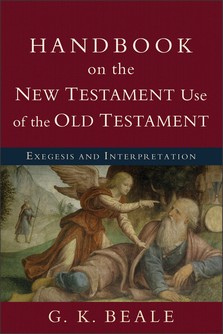 G. K. Beale’s new Handbook on the New Testament Use of the Old Testament: Exegesis and Interpretation (Baker Academic, 2012) identifies five assumptions or presuppositions of the New Testament which affects how they understood and use the Old Testament:
G. K. Beale’s new Handbook on the New Testament Use of the Old Testament: Exegesis and Interpretation (Baker Academic, 2012) identifies five assumptions or presuppositions of the New Testament which affects how they understood and use the Old Testament:
- There is the apparent assumption of corporate solidarity or representation.
- In the light of corporate solidarity or representation, Christ as the Messiah is viewed as the true Israel of the OT and the true Israel—the church—in the NT. [Thus, e.g., Isa. 49:3-6 and the use of Isa. 49:6 in Luke 2:32; Acts 13:47; 26:23; note how Christ and the church fulfill what is prophesied of Israel in the OT. Beale notes, “one can hold to the notion of Christ as true Israel and still have room for a hope that the majority of ethnic Jews will be saved as some point in the future. Any such salvation would be in their identification with Christ as true Israel.”]
- History is unified by a wise and sovereign plan so that the earlier parts are designed to correspond and point to the later parts (cf., e.g., Matt. 5:17; 11:13; 13:16-17).
- The age of eschatological fulfillment has come in Christ. [See, e.g., Mark 1:15; Acts 2:17; 1 Cor. 10:11; Gal. 4:4; 1 Tim. 4:1; 2 Tim. 3:1; Heb. 1:2; 9:26; 1 Pet. 1:20; 2 Pet. 3:3; 1 John 2:18; Jude 18.]
- As a consequence of the preceding presupposition, it follows that the later parts of biblical history function as the broader context for interpreting earlier parts because they all have the same, ultimate divine author who inspires the various human authors. One deduction from this premise is that Christ is the goal toward which the OT pointed and is the end-time center of redemptive history, which is the key to interpreting the earlier portions of the OT and its promises. [On this, cf. 2 Cor. 1:20; Matt. 5:17; 13:11, 16-17; Luke 24:25-27, 32, 44-45; John 5:39; 20:9; Rom. 10:4.]
Beale also summarizes the steps of his methodology:
- Identify the OT reference. Is it a quotation or allusion? If it is an allusion, then there must be validation that it is an allusion, judging by the criteria discussed in the preceding chapter.
- Analyze the broad NT context where the OT reference occurs.
- Analyze the OT context both broadly and immediately, especially thoroughly interpreting the paragraph in which the quotation or allusion occurs.
- Survey the use of the OT text in early and late Judaism that might be of relevance to the NT appropriation of the OT text.
- Compare the texts (including their textual variants): NT, LXX, MT, and targums, early Jewish citations (DSS, the Pseudepigrapha, Josephus, Philo). Underline or color-code the various differences.
- Analyze the author’s textual use of the OT. (Which text does the author rely on, or is the author making his own rendering, and how does this bear on the interpretation of the OT text?)
- Analyze the author’s interpretative (hermeneutical) use of the OT.
- Analyze the author’s theological use of the OT.
- Analyze the author’s rhetorical use of the OT.
So how does this actually work in practice?
The best thing to do would be to pick up a copy of his book. You can go here to read Beale’s introduction and first chapter for free. You can also see this methodology played out through the New Testament in Commentary on the New Testament Use of the Old Testament, edited by Beale and Carson.
You can also listen to (or watch below) an hour-long lecture by Dr. Beale on Matthew’s use of Hosea 11:1 in Matthew 2:15, where it says that Joseph, Mary, and Jesus stayed in Egypt until the death of Herod, and that “this was to fulfill what the Lord had spoken by the prophet, ‘Out of Egypt I called my son.'”
As Beale explained in one interview, “The problem is, when you go back to Hosea 11:1, it’s not a prophecy. It’s just a description of Israel coming out of Egypt hundreds of years earlier. If a student were asked on test, ‘Is Hosea 11:1 a prophetic statement?’ many teachers would give them an F if they said yes.”
If you’re looking for a summary of Beale’s answer, here it is in a paragraph from another interview:
I contend that throughout the book of Hosea itself not only is the first exodus mentioned quite a bit, but so too a second exodus that was to occur in the latter days. The best example is Hosea 11. In verse 1 he mentions the historical exodus, but the chapter concludes with the prophecy that God will bring them out of Egypt in the future. In fact, in the middle of the chapter it even says they will return to Egypt a second time. There are a number of places where Hosea mentions a first exodus and elsewhere a second exodus, and he does this right in chapter 11 multiple times. If you asked Hosea “Hosea, did you see that the end of Israel’s history was to be shaped like its beginning at the exodus?” I think he would say, “Yes.” That’s why Hosea sees that there is going to be a future exodus that is replicating or recapitulating a first exodus. If that’s the case, then Matthew is just recognizing Hosea’s own typological method.


















